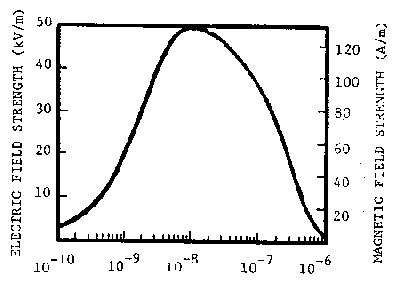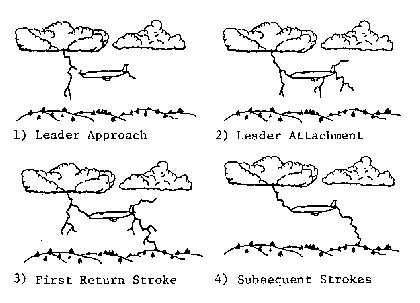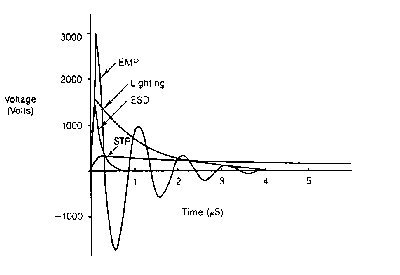
Figure 1 - Generalized High Altitude EMP Electric and Magnetic Field Time Waveform
AN INTRODUCTION TO THE EMP AND LIGHTNING THREAT
Bruce C. Gabrielson, PhD
Sachs/Freeman Associates, Inc.
1401 McCormick Drive
Landover, MD 20785
Abstract - Although generated by different mechanisms, lightning and EMP threats to electronic circuits can often be analyzed in similar fashion. The two threats of concern are the electromagnetic field and the generated voltage pulse appearing at interface circuits. This paper addresses the origins of EMP and lightning generated threats in order to lay the foundation for their simultaneous treatment using similar analytical and protection approaches.
Electromagnetic Pulse Origins
EMP, or electromagnetic pulse, is the effect of the radiated energy created when high energy gamma rays knock electrons free from air molecules during a nuclear weapon detonation. These free electrons are called Compton electrons, and their movement in relation to the earth's magnetic field is the source of this radiated electromagnetic energy known as EMP.
Nuclear detonations are normally grouped into three general classifications: surface bursts, high altitude endoatmospheric bursts, and exoatmospheric bursts. For low altitude surface bursts, most ionizing is contained within a few hundred yards of the burst location. Freed electrons from the burst will attach themselves to neutral atmospheric particles in a few seconds. Therefore, the initial EMP pulse may be large depending on proximity to the blast, but pulse time duration should be shorter.
Since a surface burst generates EMP due to rapid ionization, two regions, one associated with the region radiated, and one associated with air volume and ground current (source region) can be identified. In the surface region, beyond 3 to 5 kilometers, radiated fields are generally well below the strengths specified for high altitude bursts. Within the source region, fields may be over twice the specified field strength of high altitude burst, about 50,000 volts/meter.
Bursts within the earth's atmosphere between 10 and 40 miles interact with the ionosphere to produce electric dipole radiation. Radiated fields at a few miles from the blast are generally two orders of magnitude lower than the 50,000 volts/meter pulse.
Exoatmospheric bursts (above about 70 miles) generate the condition usually known as high altitude EMP or HEMP. The free Compton electrons travel in a spiraling motion, and are trapped within the earth's magnetic field. This results in a broadband (10 kHz to 100 MHz) downward propagated electromagnetic wave.
HEMP is the dominant concern in most hardness design issues. Electric fields as large as 50,000 volts/meter, with 10 to 20 nanosecond risetime pulses, and with pulse durations as long as one microsecond, have been estimated [1]. Figure 1 is a generalized high altitude E and H field time waveform prediction.

Figure 1 - Generalized High Altitude EMP Electric and Magnetic Field
Time Waveform
Lightning Origins
The precise mechanism responsible for cloud charging is not fully described at presented [2]. Additionally, it is difficult to determine if the strong electric fields associated with thunderclouds are the result of precipitation or down drafts. A plausible description of the mechanism involved in thunderstorm electrification has been proposed by Peter Handel in a paper published in the Journal of Geophysical Research [3]. In this paper it is suggested that small aggregates of water and ice are saturation-polarized, and this polarization continues as the ice crystals grow.
When the ice crystals or droplets grow to a sufficient size, their combined charged potential can create a polarization catastrophe - the spontaneous alignment of all water molecule aggregates relative to each other. Handel states that a cloud will acquire a spontaneous polarization even in the absence of an externally applied electric field. Our concern here is not with the actual charge formation mechanics involved, but with the resultant threat from the effects this charge formation creates.
Lightning is basically a long spark that discharges regions of excess charge located in the atmosphere. The total lightning discharge, called a flash, is initiated by a downward (or upward) traveling spark known as the stepped leader. Each flash between charge regions is made up of a number of independent current pulses called strokes.
Once a stepped leader gets close to the opposite charge center (or ground), a stroke is initiated from the charge center that propagates back up the ionized channel left by the leader's passage. Return strokes have higher amplitude since they grow by collecting the charges left by the downward moving leader [4].
The lightning strike process of concern to engineers is better understood than the charging mechanics involved [5], and is shown in Figure 2. As the leader approaches an aircraft, corona effects, called streamers, are simultaneously generated from opposite ends of the vehicle. Once these streamers attach to the stepped leader, the air breakdown potential between the vehicle and ground is exceeded and the channel is completed to ground. The first return stroke neutralizes the immediate charge center initiating the leader, with subsequent strokes neutralizing other nearby charge centers of insufficient strength to initiate their own discharge independently.

Figure 2 - The Lightning Strike Process
Two aspects of the lightning threat to a vehicle must be considered by the design engineer: nearby strikes generate radiated electromagnetic fields, while direct strike attachments actually involve pulsed current flow within an object or vehicle. Current flowing within a conductor creates additional radiated E and H fields that can result in voltage pulses being induced on other conductors, or in circuits. Since direct attachments involve the most energy transfer, 100 k amps (90 percentile), it is the joule heating from direct attachments that causes the most concern to structural designers, and the induced voltage pulse that causes the most concern to circuit design engineers.
In conclusion, although actual generation mechanisms are different, both EMP and lightning result in an electrical pulse threat that can be addressed with similar analysis, test, and circuit protection techniques. Figure 3 shows a comparison of electrical transients for EMP, lightning, ESD, and a standard transient pulse (STP) [6].

Figure 3. Comparison of Electrical Transients for Various Threats
References